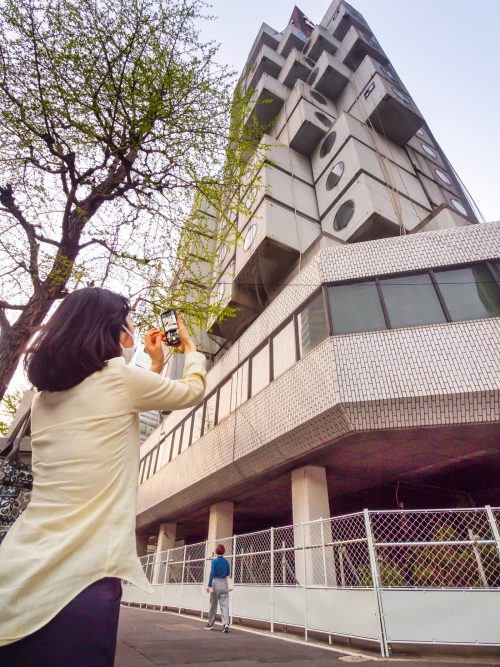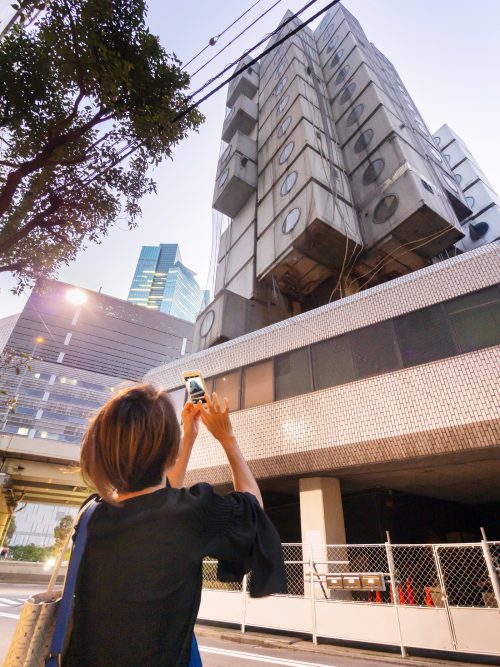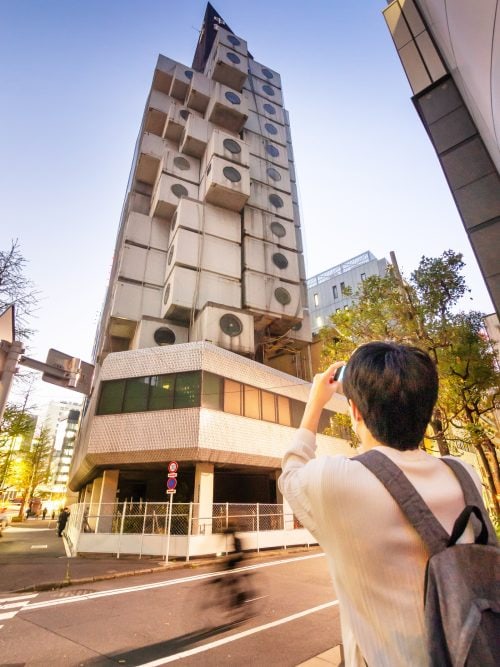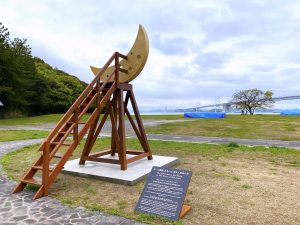The Nakagin Capsule Tower Designed by renowned architect Kisho Kurokawa and completed in 1972
The announced demolition of the iconic Nakagin Capsule Tower began a few days ago, after years of preservation attempts and uncertainty about its fate. According to Tatsuyuki Maeda of the Nakagin Capsule Tower Building Preservation and Regeneration Project – the organization that promoted the conservation campaign – unsuccessful attempts have been made in the last years to involve local authorities and UNESCO. Docomomo International also shortlisted the tower as a world heritage of Modern Buildings and Sites.
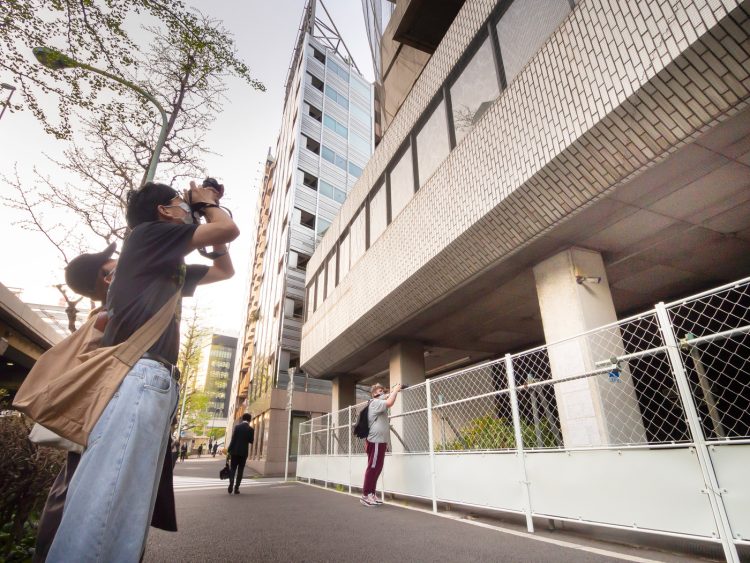
All photos by Lamberto Rubino
Unfortunately, "Japan does not have the legislation to preserve this kind of architectural culture," according to Maeda. Moreover, in the last decades, the building had fallen into disrepair. It also contains asbestos, which was widely used in construction when it was built.
Designed by renowned architect Kisho Kurokawa and completed in 1972, the Nakagin was the first capsule architecture erected for habitation. Besides having been a landmark for the city of Tokyo for years, the building is also a fascinating example of retrofuturism proposed by Metabolism. It conveys the ideas of the future imagined at that time, a period of radical and liberated architecture. Together with Archigram, Yona Friedman, Superstudio, and others, the Metabolism Movement proposed radical visions for the future cities and the life of their inhabitants.
The movement emerged from the ruins of World War II and was formalized at the Tokyo World Design Conference in 1960. Its members – a group of young architects including Kiyonori Kikutake, Kisho Kurokawa, Fumihiko Maki, and critic Noboru Kawazoe – were deeply influenced by their professor Kenzo Tange. They believed in architecture as a tool to rethink society by creating buildings that could change and evolve similarly to living organisms. Hence the term metabolism, a word that describes the growth and adaptation of cells.
"We regard human society as a vital process - a continuous development from atom to nebula," says their Manifesto. "The reason why we use such a biological word, metabolism, is that we believe design and technology should be a denotation of human society."
Unlike radical architecture, the Japanese Metabolism added a spiritual meaning to the biological metaphor. Indeed shinchintaisha (新陳代謝) - the Japanese word for Metabolism - included the Buddhist concept of transience and regeneration.
The concept of mujō (無常) – or the impermanence of things - has shaped Japanese architecture for centuries in a country often devastated by earthquakes, floods, and tsunamis. If buildings can grow and adapt, they also become more resilient to wars and natural disasters. This disrupting logic generated a genuinely organic architecture conceived to emulate the biological processes. It has laid the foundations for today's sustainable design.
Metabolism's constructions were conceived as similar to trees, with a stable and robust structure (trunk) to which light and perishable units were anchored (leaves). The concept of capsule best identifies the architecture of that period. It was born from this idea of interchangeability and adaptability. The capsules could be removed and updated or even relocated. A legend says that Kurokawa, in designing the Nakagin Capsule Tower, got inspiration from his son playing with Lego.
In one of his books, Kisho Kurokawa provided a clear description of Metabolism in architecture. "I thought that architecture is not permanent art, something that is completed and fixed, but rather something that grows towards the future, is expanded upon, renovated, and developed." His design philosophy focused on the notions of impermanence, materiality, and sustainability since he proposed the transition from the "Age of Machine" to the "Age of Life."
The traditional Sukiya architecture profoundly influenced Kurokawa. The concept of Capsule architecture is probably derived from the tea house and its minimal design. He mentioned kochuu, referring to the Japanese tradition of constructing minimum spaces that recreate a separate universe.
This interest in the minimal cell for living was also at the center of the research of modernist architects. In 1951 Le Corbusier created the Cabanon de Vacances, the only building constructed for himself as a refuge to work and find inspiration. Similarly, in 1973 Kurokawa built the Capsule K in Nagano as his villa, re-proposing the concept adopted for the Nakagin. While in Nagano, the capsule was conceived as a space to isolate, the Nakagin Capsule was designed to host what he defined as the Homo Movens , the hyperactive metropolitan businessman.
"Until now, home life, work, and leisure have been separated into different spaces and geographical zones. However, with our twenty-four-hour days, life is becoming more complex and multi-layered", wrote Kurokawa. To understand this concept, it is essential to consider Tokyo as a transitional space rather than a typical city. Homes are just random spaces to spend a few hours of rest. The concept behind Nakagin was highly innovative with its attempt to recreate a city within the building. The capsules could be used as homes, offices, or meeting spaces. A secretary service and a cafeteria were also included on the second floor. After the Nakagin, the capsule concept has declined in Tokyo in several ways, such as the capsule hotels or the manga cafes.
In an interview taken in 2007, Kurokawa discussed Nakagin and its fate. He mentioned that if the capsules had been replaced every twenty-five years as planned, they could have lasted two hundred years. He had also stressed the necessity of maintenance, which unfortunately was lacking throughout the life of the building.
It must be said that the design of Nakagin also had some significant problems that influenced its capacity to resist aging. For example, the replacement of the capsules was complicated by how they were anchored, which made it necessary to remove all the modules simultaneously. That was almost impossible since the owners were all different.
The demolition of Nakagin Capsule is a bitter chapter of Tokyo history, but possibly this fate is coherent with the concept of impermanence that shaped it. The capsules were conceived to be detached and relocated. One of the modules is already on display at the Museum of Modern Art, designed by Kurokawa. Other capsules will be recycled and sent to museums in Japan and abroad. Albeit in a different form, Kurokawa's masterpiece will survive and spread its message worldwide.

 日本語
日本語 English
English


